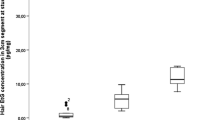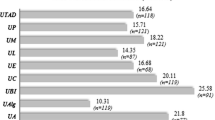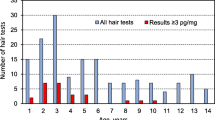Abstract
Background
Despite the growing importance of ethyl glucuronide (EtG) in hair for detection of chronic excessive alcohol consumption, the mechanism of incorporation is not yet clear. Deposition from sweat is believed to be the main route. In order to get more information, EtG was determined in daily shaved beard hair after single higher alcohol doses.
Methods
Three volunteers drank within 5.5 h 153, 165 and 200 g ethanol followed by abstinence. Daily shaved beard hair was analysed for EtG using a validated liquid chromatography–tandem mass spectrometry method with a limit of quantification of 2 pg/mg.
Results
For all three volunteers, small concentrations of EtG were already detected 9 h after end of drinking. The concentrations increased to maxima of 182, 242 and 74 pg/mg on days 2 to 4 and then gradually decreased to limit of quantification on days 8 to 10.
Discussion
The time course of EtG is discussed based on literature data about anatomic dimensions of the hair root, physiology of hair growth, kinetics of EtG formation and elimination in blood, and in comparison to literature results about drugs in beard hair. It follows that for beard hair the predominant portion of EtG is incorporated in the upper part of the hair root between suprabulbar region and isthmus leading to a positive zone of about 3 mm (8–9 days) after a single drinking event. Deposition from sweat which is only possible into the residual hair stubble after shaving and in the infundibulum down to the sebaceous gland mouth was found to be of minor importance but could play a greater role in long hair.
Conclusion
It is concluded that EtG in hair fulfils the prerequisites for time-resolved interpretation of segmental concentrations and that a single excessive drinking can be well detected in sufficiently short hair segments. However, in the routinely investigated 3-cm proximal scalp hair segment and using the cutoff of 7 pg/mg, a negative result can be expected with high probability because of dilution by negative hair.



Similar content being viewed by others
References
Pragst F, Yegles M (2006) Alcohol markers in hair. In: Kintz P (ed) Analytical and practical aspects of drug testing in hair. CRC Taylor & Francis, Boca Raton, pp 287–323
Pragst F, Rothe M, Moench B, Hastedt M, Herre S, Simmert D (2010) Combined use of fatty acid ethyl esters and ethyl glucuronide in hair for diagnosis of alcohol abuse. Interpretation and advantages. For Sci Int 196:101–110
Suesse S, Pragst F, Mieczkowski T, Selavka CM, Elian A, Sachs H, Hastedt M, Rothe M, Campbell J (2011) Practical experiences in application of hair fatty acid ethyl esters and ethyl glucuronide for detection of chronic alcohol abuse in forensic cases. Forensic Sci Int 218(1–3):82–91
Kharbouche H, Sporkert F, Troxler S, Augsburger M, Mangin P, Staub C (2009) Development and validation of a gas chromatography–negative chemical ionization tandem mass spectrometry method for the determination of ethyl glucuronide in hair and its application to forensic toxicology. J Chromatogr B Analyt Technol Biomed Life Sci 877:2337–2343
Morini L, Politi L, Polettini A (2009) Ethyl glucuronide in hair. A sensitive and specific marker of chronic heavy drinking. Addiction 104:915–920
Agius R, Nadulski T, Kahl H-G, Dufaux B (2011) Ethyl glucuronide in hair—a highly effective test for the monitoring of alcohol consumption. Forensic Sci Int 218(1–3):10–14
Pirro V, Valente V, Oliveri P, De Bernardis A, Salomone A, Vincenti M (2011) Chemometric evaluation of nine alcohol biomarkers in a large population of clinically-classified subjects: pre-eminence of ethyl glucuronide concentration in hair for confirmatory classification. Anal Bioanal Chem 401:2153–2164
Kharbouche H, Faouzi M, Sanchez N, Daeppen JB, Augsburger M, Mangin P, Staub C, Sporkert F (2012) Diagnostic performance of ethyl glucuronide in hair for the investigation of alcohol drinking behavior: a comparison with traditional biomarkers. Int J Legal Med 126:243–250
Morini L, Varango C, Filippi C, Rusca C, Danesino P, Cheli F, Fusini M, Iannello G, Groppi A (2011) Chronic excessive alcohol consumption diagnosis: comparison between traditional biomarkers and ethyl glucuronide in hair, a study on a real population. Ther Drug Monit 33:654–657
Schummer C, Appenzeller BMR, Wennig R (2008) Quantitative determination of ethyl glucuronide in sweat. Ther Drug Monit 30:536–539
Kharbouche H, Steiner N, Morelato M, Staub C, Boutrel B, Mangin P, Sporkert F, Augsburger M (2010) Influence of ethanol dose and pigmentation on the incorporation of ethyl glucuronide into rat hair. Alcohol 44:507–514
Cone EJ (1990) Testing human hair for drugs of abuse. I. Individual dose and time profiles of morphine and codeine in plasma, saliva, urine, and beard compared to drug-induced effects on pupils and behavior. J Anal Toxicol 14:1–7
Nakahara Y, Takahashi K, Konuma K (1993) Hair analysis for drugs of abuse. VI. The excretion of methoxyphenamine and methamphetamine into beards of human subjects. Forensic Sci Int 63:109–119
Gwent SH, Wilson JF, Tsanaclis LM, Wicks JF (1995) Time course of appearance of cotinine in human beard hair after a single dose of nicotine. Ther Drug Monit 17:195–198
Kintz P, Tracqui A, Mangin P (1993) Pharmacological studies on meprobamate incorporation in human beard hair. Int J Legal Med 105:283–287
Callaghan RR, Wilson JF, Cartwright J (1996) An assessment of the routes of incorporation of opiates into beard hair after a single oral dose of codeine. Ther Drug Monit 18:724–728
Yegles M, Wenning R (2000) Incorporation of propyphenazone in beard hair of a migraine patient. Forensic Sci Int 107:233–237
Bernert JT, Alexander JR, Sosnoff CS, McGuffey JE (2011) Time course of nicotine and cotinine incorporation into samples of nonsmokers' beard hair following a single dose of nicotine polacrilex. J Anal Toxicol 35:1–7
Robbins CR (2002) Chemical and physical behavior of human hair, 4th edn. Springer, New York
Sperling LC (1991) Hair anatomy for the clinician. J Am Acad Dermatol 25:1–17
Vogt A, Hadam S, Heiderhoff M, Audring H, Lademann J, Sterry W, Blume-Peytavi U (2007) Morphometry of human terminal and vellus hair follicles. Exp Dermatol 16:946–950
Blume-Peytavi U, Vogt A (2011) Human hair follicle: reservoir function and selective targeting. Br J Dermatol 165(Suppl 2):13–17
Harkey MR (1993) Anatomy and physiology of hair. Forensic Sci Int 63:9–18
Pötsch L, Skopp G, Eser HP, Moeller MR (1996) Zum Suchtmittelnachweis in Kopfhaaren I. Die Abschätzung und Bedeutung des individuellen Haarwachstumsfensters und des intradermalen Abschnittes anagener Haare bei der segmentweisen Haaranalyse. Rechtsmedizin 6:156–160
Pötsch L (1996) A discourse on human hair fibers and reflections on the conservation of drug molecules. Int J Legal Med 108:285–293
Pötsch L, Skopp G, Moeller MR (1997) Biochemical approach on the conservation of drug molecules during hair fiber formation. Forensic Sci Int 84:25–35
Pragst F, Rothe M, Spiegel K, Sporkert F (1998) Illegal and therapeutic drug concentrations in hair segments—a timetable of drug exposure. Forensic Sci Rev 10:81–111
Pragst F, Balikova MA (2006) State of the art in hair analysis for detection of drug and alcohol abuse. Clin Chim Acta 370:17–49
Colin THJ (2004) Laser hair reduction and non-ablative laser skin rejuvenation. SGH Proceedings 13:64–68
Randall VA, Ebling FJ (1991) Seasonal changes in human hair growth. Br J Dermatol 124:146–151
Nagl W (1995) Different growth rates of pigmented and white hair in the beard: differentiation vs. proliferation? Br J Dermatol 132:94–97
Droenner P, Schmitt G, Aderjan R, Zimmer H (2002) A kinetic model describing the pharmacokinetics of ethyl glucuronide in humans. Forensic Sci Int 126:24–29
Høiseth G, Bernard JP, Karinen R, Johnsen L, Helander A, Christophersen AS, Mørland J (2007) A pharmacokinetic study of ethyl glucuronide in blood and urine: applications to forensic toxicology. Forensic Sci Int 172:119–124
Høiseth G, Morini L, Polettini A, Christophersen A, Mørland J (2009) Blood kinetics of ethyl glucuronide and ethyl sulphate in heavy drinkers during alcohol detoxification. Forensic Sci Int 188:52–56
Halter CC, Dresen S, Auwaerter V, Wurst FM, Weinmann W (2008) Kinetics in serum and urinary excretion of ethyl sulfate and ethyl glucuronide after medium dose ethanol intake. Int J Legal Med 122:123–128
Buono MJ (1999) Sweat ethanol concentrations are highly correlated with co-existing blood values in humans. Exp Physiol 84:401–404
Abanades S, Farré M, Segura M, Pichini S, Pastor A, Pacifici R, Pellegrini M, Torre R (2007) Disposition of gamma-hydroxybutyric acid in conventional and nonconventional biologic fluids after single drug administration: issues in methodology and drug monitoring. Ther Drug Monit 29:64–70
Schwilke EW, Barnes AJ, Kacinko SL, Cone EJ, Moolchan ET, Huestis MA (2006) Opioid disposition in human sweat after controlled oral codeine administration. Clin Chem 52:1539–1545
Kacinko SL, Barnes AJ, Schwilke EW, Cone EJ, Moolchan ET, Huestis MA (2005) Disposition of cocaine and its metabolites in human sweat after controlled cocaine administration. Clin Chem 51:2085–2094
Barnes AJ, Smith ML, Kacinko SL, Schwilke EW, Cone EJ, Moolchan ET, Huestis MA (2008) Excretion of methamphetamine and amphetamine in human sweat following controlled oral methamphetamine administration. Clin Chem 54:172–180
Barnes AJ, De Martinis BS, Gorelick DA, Goodwin RS, Kolbrich EA, Huestis MA (2009) Disposition of MDMA and metabolites in human sweat following controlled MDMA administration. Clin Chem 55:454–462
Shibasaki M, Wilson TE, Crandall CG (2006) Neural control and mechanisms of eccrine sweating during heat stress and exercise. J Appl Physiol 100:1692–1701
Saga K (2002) Structure and function of human sweat glands studied with histochemistry and cytochemistry. Prog Histochem Cytochem 37:323–386
Henderson GL (1993) Mechanisms of drug incorporation into hair. Forensic Sci Int 63:19–29
Appenzeller BM, Schuman M, Yegles M, Wennig R (2007) Ethyl glucuronide concentration in hair is not influenced by pigmentation. Alcohol Alcohol 42:326–327
Author information
Authors and Affiliations
Corresponding author
Rights and permissions
About this article
Cite this article
Schräder, J., Rothe, M. & Pragst, F. Ethyl glucuronide concentrations in beard hair after a single alcohol dose: evidence for incorporation in hair root. Int J Legal Med 126, 791–799 (2012). https://doi.org/10.1007/s00414-012-0729-z
Received:
Accepted:
Published:
Issue Date:
DOI: https://doi.org/10.1007/s00414-012-0729-z




